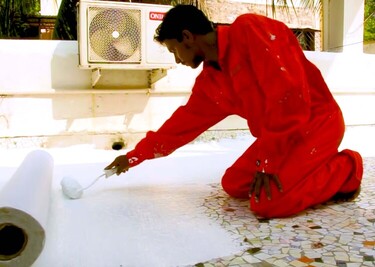Homeowners often face the challenge of protecting terraces from rain, heat, and long-term damage.
Two popular solutions are terrace waterproofing and terrace shade.
Both serve unique purposes.
Choosing the right one depends on your building structure, climate, and budget.
This guide helps you understand both options and pick the better solution for your needs.
Understanding terrace waterproofing vs shade

Terrace waterproofing is the process of applying a protective layer to the terrace surface to prevent water from seeping through.
It involves materials like liquid membranes, bituminous coatings, or polymer-based sealants.
The goal is to seal the surface completely, so rainwater doesn’t seep into the structure.
It helps avoid structural cracks, dampness, fungus, and mold inside the home.
Waterproofing is crucial in regions with heavy rainfall or poor drainage systems.
It also extends the building’s life and reduces future repair costs.
In modern construction, terrace waterproofing is often included at the base level during slab casting.
However, older buildings require retrofitting with waterproofing layers.
The longevity of waterproofing systems depends on the product quality and application method.
If done well, it can last 8–10 years with minimal maintenance.
What is a Terrace Shade and Its Purpose?
A terrace shade is a physical structure—usually made from metal, polycarbonate, or fabric—that protects the terrace from direct sun and rain.
Unlike waterproofing, which treats the surface itself, a shade acts as a barrier above the terrace.
Its primary function is to provide shade, reduce heat buildup, and protect against UV exposure.
It also allows for comfortable use of the terrace during hot or rainy seasons.
Terrace shades are ideal for homes that want a usable outdoor space, such as a seating area or garden.
They improve comfort without altering the terrace surface.
Modern terrace shades come in various designs—retractable, fixed, or even solar-panel integrated structures.
However, while a shade protects from rainfall impact, it doesn’t seal or treat the terrace surface, leaving it vulnerable to seepage.
Key Differences Between terrace waterproofing vs shade
| Feature | Terrace Waterproofing | Terrace Shade |
| Protection Type | Water barrier on surface | Physical shelter above surface |
| Focus Area | Prevents seepage | Blocks heat & direct rain |
| Usability | Doesn’t create usable area | Creates usable outdoor space |
| Lifespan | 8–10 years | 10–15 years (depending on material) |
| Maintenance | Minimal if done well | Requires cleaning, tightening |
Pros and Cons of Terrace Waterproofing
✅Terrace Waterproofing Pros:
- Prevents structural water damage
- Reduces internal dampness and leakage
- Low maintenance after application
- Enhances building durability
❌Terrace Waterproofing Cons:
- Doesn’t reduce heat
- Doesn’t add usable space
- Requires skilled professionals
- Needs reapplication after years
Pros and Cons of Terrace Shade
✅ Terrace Shade Pros:
- Provides shade and cooling
- Adds functional space
- Aesthetic appeal
- Good for mild rainy areas
❌ Terrace Shade Cons:
- Doesn’t stop seepage from standing water
- Requires cleaning and hardware maintenance
- May not withstand strong winds or storms
- The initial installation cost can be high
Cost Comparison – terrace waterproofing vs shade
Waterproofing:
Ranges from ₹40 to ₹120 per sq. ft, depending on materials and labour.
A mid-sized terrace may cost around ₹25,000–₹50,000.
Terrace Shade:
Costs ₹150 to ₹450 per sq. ft based on materials and design.
A similarly sized terrace can cost ₹75,000–₹2,00,000+.
If budget is a major factor and seepage is the concern, waterproofing is cost-effective.
For usability and aesthetics, shades offer more value.
Best Situations to Choose Waterproofing
If your building is old and showing signs of leakage, wall dampness, or ceiling cracks, waterproofing is essential.
Especially in high rainfall or humid climates, it prevents long-term structural issues.
Climate Considerations
Waterproofing is a must in coastal or monsoon-heavy areas like Kerala, Goa, or Mumbai.
Maintenance Factors
Once applied correctly, the system requires very little maintenance—just annual inspection and cleaning.
When is Terrace Shade a Better Option?
If you want to use the terrace for seating, gardening, or family time, terrace shade is a better fit.
It also helps reduce the internal temperature of top-floor rooms by blocking direct sunlight.
Climate Considerations
Suitable for regions with hot summers but less rainfall, like Delhi, Rajasthan, or Telangana.
Maintenance Factors
Shades may require more frequent checks for rust, wear and tear, and stability, especially after storms.
Conclusion – What Should You Choose?
Both terrace waterproofing and terrace shade solve different problems.
You might even combine both—first waterproofing, then installing a shade structure for double protection.
Final Thoughts
- Choose waterproofing if your goal is structural safety and long-term cost savings.
- Choose shade if your focus is comfort, cooling, and usability.
For best results, consult a building expert to assess your specific situation
- Why Retrofitting is Important for Buildings: Structural Strengthening, Waterproofing & Building Repairs with Zindus
- Seal the Deal: Why Terrace Waterproofing is the Smartest Investment for Old Buildings
- Say Goodbye to Damp Walls! Weatherproof Painting & Waterproofing Secrets Revealed
- Rehabilitation Redefined | Strengthen, Beautify & Protect Old Structures – Zindus
- Revive Aging Buildings with Modern Waterproofing | Zindus

“Nice blog! It cleared all my doubts about structural repairs and waterproofing. Also, if you’re looking for farmland to build your dream home, do check out http://www.mahabhoomi.site“
Interesting read! This blog clearly explains the pros and cons of terrace waterproofing and shade solutions. Both options have their place depending on your needs—shade for comfort and waterproofing for structural protection. For anyone looking to enhance their outdoor space, this is a must-read.
Also, if you’re passionate about mastering strategy and focus like in home planning, check out Chess No.1 Academy – where future champions are trained!